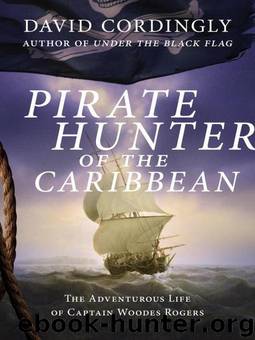Pirate Hunter of the Caribbean by David Cordingly

Author:David Cordingly
Language: eng
Format: mobi, epub
Tags: History
ISBN: 9780679644217
Publisher: Random House
Published: 2011-05-01T00:00:00+00:00
9
Welcome to Nassau
At 4 p.m. on 25 July 1718 the lookouts on HMS Rose sighted the eastern end of the island of New Providence. Captain Whitney had been ordered by Commodore Chamberlain to go ahead of the squadron and lead the way from the outer island of Eleuthera, past Harbour Island and the off-lying reefs, to Nassau. The 20-gun warship made good progress in a strong breeze and by 6 p.m. she was approaching the harbour entrance. The pilot guided her through the channel until she was able to drop anchor in three to four fathoms. Ahead was a long, narrow stretch of water with Hog Island on one side and the derelict waterfront of Nassau on the other side, the only prominent landmark being the crumbling walls and bastions of the fort. Thirty or forty merchant vessels of various nationalities were at anchor in the channel or were lying half-submerged in the shallows, their scorched black timbers indicating that they had been set on fire before sinking.1 Several of the vessels at anchor were stripped of their fittings and some were missing masts, bowsprits and rigging. There were a few visiting trading ships and brigs but most in evidence were the pirate sloops – powerful-looking vessels in good order and well armed with carriage guns and swivel guns.
The largest vessel in the anchorage was a French-built merchantman of 22 or 24 guns which was flying the St George’s flag of England at her maintopmast head. To the surprise of Captain Whitney and his crew she fired three shots at the Rose. Whitney lowered a boat and sent his first lieutenant across to know the reason for this hostile action. The lieutenant discovered that the captain of the ship was the pirate Charles Vane. Most of his crew appeared to be drunk and when Vane was asked why he had opened fire ‘his answer was, he would use his utmost endeavour to burn us, and all the vessels in the harbour that night’.2
At around 7 p.m. the Shark, the Buck and the transport ship Willing Mind negotiated the harbour entrance and anchored near the Rose. The larger ships Delicia and HMS Milford remained outside until they could get a pilot to guide them in. That evening Charles Vane made his preparations. He shifted his men and valuables into two shallow-draft vessels and loaded the guns of his French prize with double shot and partridge shot. At midnight he set the ship on fire and towed her towards the new arrivals. All wooden ships were extremely vulnerable to attack by fireships. Naval ships with their magazines loaded with barrels of gunpowder were particularly vulnerable, but what made the situation at Nassau even more dangerous was the narrowness of the channel and the shallows on either side. Fortunately the British sailors were alert. As the flaming ship bore down on them, they hacked through their anchor cables, set their topsails and managed to escape out of the harbour without running aground.
The next morning the ships made their way back into the harbour, all except the Milford and Delicia.
Download
Pirate Hunter of the Caribbean by David Cordingly.epub
This site does not store any files on its server. We only index and link to content provided by other sites. Please contact the content providers to delete copyright contents if any and email us, we'll remove relevant links or contents immediately.
Fanny Burney by Claire Harman(25786)
Empire of the Sikhs by Patwant Singh(22173)
Out of India by Michael Foss(16312)
Leonardo da Vinci by Walter Isaacson(11906)
Small Great Things by Jodi Picoult(6096)
The Six Wives Of Henry VIII (WOMEN IN HISTORY) by Fraser Antonia(4791)
The Wind in My Hair by Masih Alinejad(4425)
The Lonely City by Olivia Laing(4121)
The Crown by Robert Lacey(4106)
A Higher Loyalty: Truth, Lies, and Leadership by James Comey(4034)
The Iron Duke by The Iron Duke(3640)
Millionaire: The Philanderer, Gambler, and Duelist Who Invented Modern Finance by Janet Gleeson(3570)
Sticky Fingers by Joe Hagan(3454)
Alive: The Story of the Andes Survivors by Piers Paul Read(3313)
Papillon (English) by Henri Charrière(3270)
Joan of Arc by Mary Gordon(3260)
Stalin by Stephen Kotkin(3087)
Aleister Crowley: The Biography by Tobias Churton(3021)
Ants Among Elephants by Sujatha Gidla(2925)
